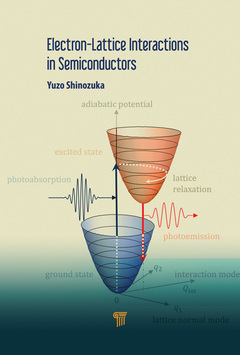Electron–Lattice Interactions in Semiconductors
Auteur : Shinozuka Yuzo

This book presents theoretical treatments on various electronic and atomic processes in non-metallic materials from a unified point of view. It starts with the basic properties of semiconductors, treating the system as a macroscopic association of electrons and ions. In their ground state, fruitful results are derived, such as the band theory for electrons in a periodic lattice and a useful concept of ?hole.? The electron?lattice interaction is then introduced as a dynamical response of condensed matter when it is electronically excited. With the aid of proper configuration coordinate diagrams, various phenomena are precisely examined, including carrier scattering, polaron formation, lattice relaxation, Stokes shift and phonon side band in optical spectrum, intrinsic and extrinsic self-trapping, and structural changes. The book provides readers a deep understanding of the physics underlying these phenomena and excellent insight to develop their further research. Graduate students who have finished the basic study on solid-state physics and quantum mechanics and research scientists and engineers in materials science and engineering will benefit immensely from it.
Perfect Crystal. Electron–Lattice Interaction. Configuration Coordinate Diagram. Localization: Self-Trapping
Electron–Lattice Interactions at Deep-Level Defects. Nonradiative Multiphonon Capture and Recombination Processes. Symmetry Breaking Processes. Stability of Materials and Novel Structures.
Yuzo Shinozuka completed his doctoral thesis on “Two Band Model for Nonradiative Multiphonon Recombination at Deep-Level Defects in Semiconductors” from the University of Tokyo, Japan, in 1980.
Date de parution : 03-2021
15.2x22.9 cm
Disponible chez l'éditeur (délai d'approvisionnement : 15 jours).
Prix indicatif 143,25 €
Ajouter au panierThèmes d’Electron–Lattice Interactions in Semiconductors :
Mots-clés :
Electron Lattice Interaction; STM Image; lattice vibrations; Adiabatic Potentials; semiconductor theory; Elastic Potential Energy; electron band theory; CCD; electron-lattice interaction; Effective Mass Approximation; electro-atomic processes; Deep Level Defects; Self-trapped Exciton; Valence Hole; Valence Band; Lattice Distortion; Bloch State; Large Lattice Distortion; Photo-induced Phase Transition; Force Constant Model; STM Measurement; Defect Reaction; La Mode; Free Electron State; Self-trapped State; Translational Symmetry; Lattice Relaxation; Wannier Exciton; Franck Condon Principle



